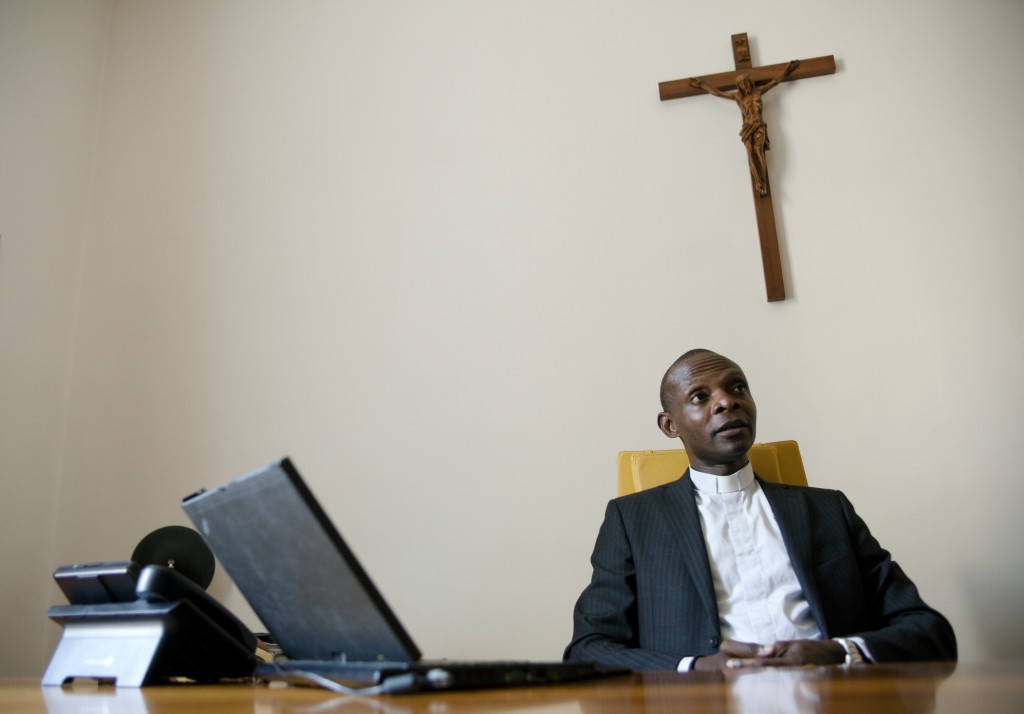
By Cindy Wooden
Father Caesar Atuire is not naive enough to ask his pilgrims to leave their smartphones at home.
However, the CEO of a Vatican-related pilgrimage agency does ask his pilgrims to at least look at the holy sites – perhaps even say a prayer – before clicking and capturing the moment in a photo, text message, Tweet or Facebook post.
Father Atuire, a Ghanaian-born priest of the Diocese of Rome, personally leads at least three of the pilgrimages he oversees each year for Opera Romana Pellegrinaggi, which organises spiritual travel from Rome for 40,000-50,000 people each year and assists about 700,000 pilgrims visiting the Eternal City annually.
More and more, he said, helping travellers become pilgrims means overcoming a fixation with images that completely overshadows experiencing the reality of setting off on a journey, meeting new people, exploring different cultures and entering into prayer.
People at audiences and Masses with Pope Benedict XVI see the pope through their camera lens, cellphones and iPads.
The same thing happens at Christian holy sites around the world, he said.
“What I insist with our pilgrims is live the experience and, if the experience is so powerful, then try to immortalise it with an image, but don’t start off with the image,” he said.
A second, similar modern obstacle to an authentic pilgrim experience is Facebook or other social networks and the general ease of communicating with others anywhere in the world.
Father Atuire talks about “being present, but absent.” He said, “I can be here with you, but all that I’m doing is geared toward telling people elsewhere what I’m doing right now.
That’s a kind of absenteeism that’s becoming very pronounced even in our pilgrimages.”
The third big risk is speed, he said.
“It takes 90 minutes to fly from Rome to Lourdes,” and as soon as the plane lands, he said, people are calling home, “asking the kids to take the laundry out of the machine. And I say, ‘Wait a minute, you still aren’t here.’”
People’s minds, hearts and souls need time to move from thoughts of work, home or school, Father Atuire said, so his agency offers catechesis on the planes.
In addition, each morning guides conduct a brief meeting to remind people of where they are and what they’re about to do.
All people need a break from the daily grind now and then, he said.
They need to get in touch again with their families, with nature, with themselves and with God.
If a person isn’t travelling for work, they usually either are “running away from something or searching for something,” the priest said.
The key difference between leisure travel and a pilgrimage is the search for a spiritual encounter, he said, and throughout history certain shrines and sites have become known as places with “a density of God’s presence,” he said.
For the priest, who travels often, the three places that top his list for “spiritual density” are the chapel of Christ’s tomb in Jerusalem’s Church of the Holy Sepulcher; the grotto where Mary appeared to St Bernadette in Lourdes, France; and the Sea of Galilee in the silence of the early morning or late evening.
“I don’t think you can do anything but pray” in those places, he said.
“Religious experience has a corporal dimension,” Father Atuire said. “When people are in search of a deep religious experience, the body somehow needs to be involved,” so setting off from home and going on a pilgrimage is quite natural, not only for Christians, but also for members of most other major religions.
Unfortunately though, he said, too many people today focus so much on getting to the holy places that they lose sight of the fact that a pilgrimage is a journey: “The road is the pilgrimage and it prepares you for the encounter.”
While a pilgrimage is a purposeful break from one’s normal routine, it’s not a break from rules and good manners, he said.
“A pilgrimage is putting order into your life, going back to put real order in your life – order in terms of your relationships with other persons, order in terms of your relationship with God,” he said.
“Sin is disorder, and a pilgrimage is an opportunity to recover that harmony that has been lost through everyday life. That’s why it’s a deeply religious experience.”
Father Atuire also has a dream file, and it already includes a detailed itinerary. He just needs to find time, resources and pilgrims.
One day, he said, he’d love to take a group to the Marian shrine at Kibeho, Rwanda, where young people reported apparitions of Mary in the 1980s; the local bishop has recognised the apparitions as authentic.
“It’s a region of Africa that is struggling to find peace, stability and growth” following the genocide of the 1990s, Father Atuire said. He would like to bring a group of pilgrims with him, “look into Our Lady’s message and see what signs of hope we can find there.”- CNS